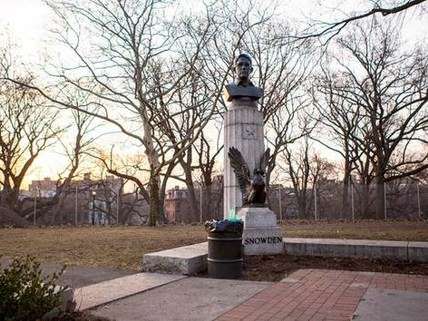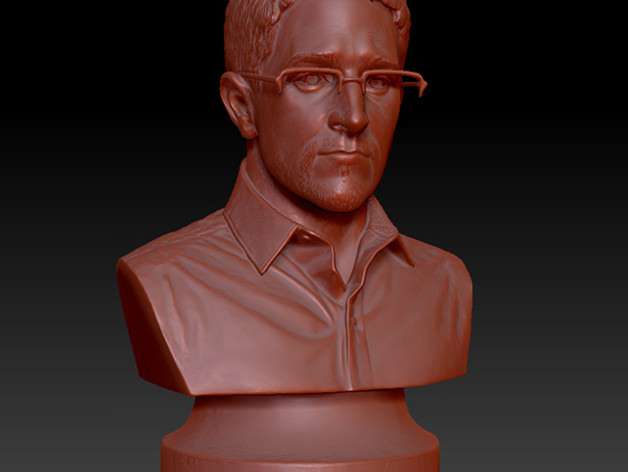Edward Snowden Statue's Co-Creator Talks With Reason About Political Art, 3D Printing, and Going Legitimate
Artists wanted to "draw a parallel between what Snowden was fighting for and the ideals that the American revolutionaries were fighting for."
The previously anonymous artists who created and erected a bust of Edward Snowden in Brooklyn's

Fort Greene Park this past April were identified by the Associated Press as Jeff Greenspan, formerly an executive at Buzzfeed and Facebook, and Andrew Tider, a veteran advertising creative and adjunct professor at the City College of New York, after the pair paid $50 fines in order to retrieve the hundred-pound statue from the New York City Police Department (NYPD).
Greenspan and Tider refer to their guerrilla art project as "The Prison Ship Martyr's Monument 2.0," a reference to the 107 year-old memorial honoring the more than 11,000 Revolutionary War prisoners who died in overcrowded British prison boats docked in the East River, which they chose as the locale for their Snowden statue.
I spoke with Tider over the phone today about what he and Greenspan hoped to achieve by putting a massive likeness of America's most famous whistle-blowing fugitive at a war memorial, the use of 3D printing technology in creating the bust, and the possibility of a permanent "legitimate" home for the Snowden statue.
Full conversation after the jump.
reason: What is the significance of the name, "The Prison Ship Martyr's Monument 2.0"?
Andrew Tider: We wanted to draw a parallel between the intent and ideals that we believe Snowden was fighting for and the ideals that the American revolutionaries were fighting for. There are about 11,000 parts of bodies entombed there. We felt like this would be a way to bring additional respect and reverence to those people who died fighting for ideals that this country was founded on. While Snowden hasn't paid the ultimate price that those people have, he has given up his safety and comfort on a level that most of us probably wouldn't be willing to. So we wanted to recognize that and frame his story as a continuation of the story of people fighting for the ideals that this country was founded on.
reason: A lot of people, including President Obama, consider Edward Snowden a traitor who has endangered American lives. What would you say to those who would object to the lionization of Snowden at a war monument?
Tider: The goal for us was not to lionize or hero-worship Snowden. Obviously, we created a bust of him, so it's hard not to argue that we didn't do that on some level. But that was the physical action. We were looking to give people the mental space to consider the larger debate, which is, "Are we, as Americans, comfortable with the level of surveillance that has been revealed (by Snowden)?"
We felt the debate about Snowden and whether he was a hero or a traitor or something in between wasn't the debate. We, as Americans, have been sort of shoved into that being the important debate. Because much of the media initially came out as anti-Snowden. The President came out and said, "this guy's a traitor."
We don't feel like it's up to us to say whether we think Snowden is a hero or a traitor. We just wanted to allow for an alternative narrative, to allow people to see Snowden in a different light. If it short-circuits the way you've been thinking about something, that's what we wanted to encourage, to have people look into things on their own. If you're going to have strong feelings about someone and condemn them and their actions, you shouldn't accept just one narrative, you should look into it yourself.
reason: What was the process like in creating the bust of Snowden?

Tider: The bust was by Doyle Trankina, who designed the original 3D blueprint and bust. We created a mold of the bust so additional full-size ones could be produced. (Trankina) molded with clay and then on top of that, there's about 5 different layers of paint. A latex layer, an oil paint layer, a powdered gold layer… it was a very elaborate process.
reason: You've shared the original 3D blueprint online. Are you hoping these will start popping up all over the world as guerrilla art?
Tider: We're trying to keep our expectations tempered. A lot of people came forward once the project had been released and said "I'd love to have one of these," or "I live in a red state and would love to have one of these on my lawn," or "I'd love to have one of these to remind me to be brave when I feel weak." We felt like that's what was important to us. That's when it became clear that we should let the information get out there.
reason: You and your creative partner, Jeff Greenspan, have pretty extensive experience working in corporate media. Now that your names are out there, do you worry about any professional backlash?
Tider: I hope not, but there is that potential. But Jeff and I both feel it's important to move in the direction in your life you feel most strongly about. If this project means someone doesn't want to work with us, that's fine. That's a self-selecting thing. Hopefully, there will be just as many who say, "I do want to work with those guys." We try to take any fear and use it in a positive way, instead of living under the rock of fear.
reason: The bust begins a brief residency at a gallery in Williamsburg tonight. Are there any future plans for the bust?
Tider: The ACLU has talked with us about displaying it on their grounds or possibly helping us get it placed in another NYC park. We've also been working with some NYC Parks Advocates who feel pretty confident that if we make the proper applications to the Parks Department that we can get it into one of the parks in a more traditional fashion.
reason: Had you considered that originally? Or did you just want to make your splash anonymously before going "legitimate"?
Tider: We hadn't considered that originally. We felt it was important to do this the way that we did. Sometimes, a project needs a little more drama in order to capture your attention so that the message it's trying to convey is received.


Show Comments (9)